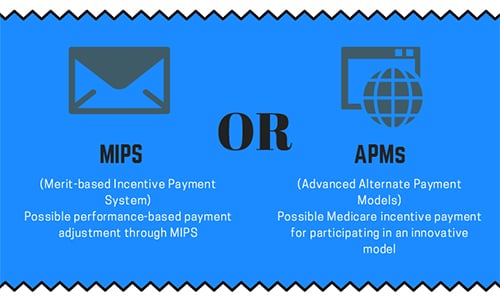The vast majority of providers will be eligible to participate in MIPS in 2017. MIPS will effectively merge many of the current quality programs that healthcare providers are familiar with, including Meaningful Use (MU), Physician Quality Reporting System (PQRS) and the Value-Based Payment Modifier (VBM).
1. Noted Changes in MIPS from 2017 to 2018
- Performance threshold raised to 15 points in Year 2 (vs. 3 points in 2017 transition year).
- MIPS Cost Category weight increased from 0% to 10% and the MIPS Quality Category decreased from 60% to 50%
- Low volume eligibility threshold raised from $30,000 to $90,000 and from 100 patients to 200 patients
- Minimum reporting period expanded from 90 days to full calendar year
2. Complaints by Providers
On April 20, 2018, 50 provider groups sent letters to the Center for Medicare and Medicaid Services (CMS) urging them to reduce the reporting period from a full calendar year to 90 days for calendar year 2018 citing they are being held accountable for data tracking beginning January 1, 2018, but were not informed of eligibility information until April 6, 2018.
The provider letters highlighted four key concerns:
- “Undersigned organizations strongly support the increased low-volume threshold and believe it will assist small practices and physicians who treat a small number of Medicare patients, but CMS may create changes in physicians’ eligibility status,” the provider groups contended.
- Without direct outreach by CMS to physicians and group practices, many physicians will be left in the dark on their status.
- “We acknowledge that certain reporting options, such as reporting certain outcome-based measures, may require a lengthier reporting period than 90 days. To ensure statistical validity, we believe there is a substantial opportunity to reduce the cost and labor involved in reporting MIPS data to CMS by shortening the minimum data collection period to 90 consecutive days and allowing physicians to decide whether to report additional data,” they wrote.
- “It is our understanding that CMS does not plan to update the website until the summer, at the earliest, which is halfway through the reporting period,” they explained. “Given the Quality Payment Program (QPP) website is the primary means for educating physicians on the program, this severe delay will undermine physicians’ ability to meet the 2018 requirements to successfully avoid a penalty.”
3. Possible Replacement for MIPS
The Medicare Payment Advisory Commission (MedPAC), a nonpartisan legislative branch agency that provides United States Congress with analysis and policy advice on the Medicare program, voted 14-2 to replace MIPS with the Voluntary Value Program (VVP) in January 2018. The VVP would apply to all Medicare providers, essentially giving them the option to voluntarily participate in an Accountable Care Organization (ACO), alternative payment model or other group OR lose 2% of Medicare reimbursement.
Opposition to the Med PAC-VPP revolves around 2 unanswered questions
- Will ACOs, alternative payment models or other groups be available for doctors to join if they want to avoid the 2% penalty?
- Will “groups” that treat sicker and poorer patients suffer?
Obviously, MIPS is fluid and ever-changing. It’s imperative that providers stay up-to-date on the most recent changes to ensure compliance with MIPS.

